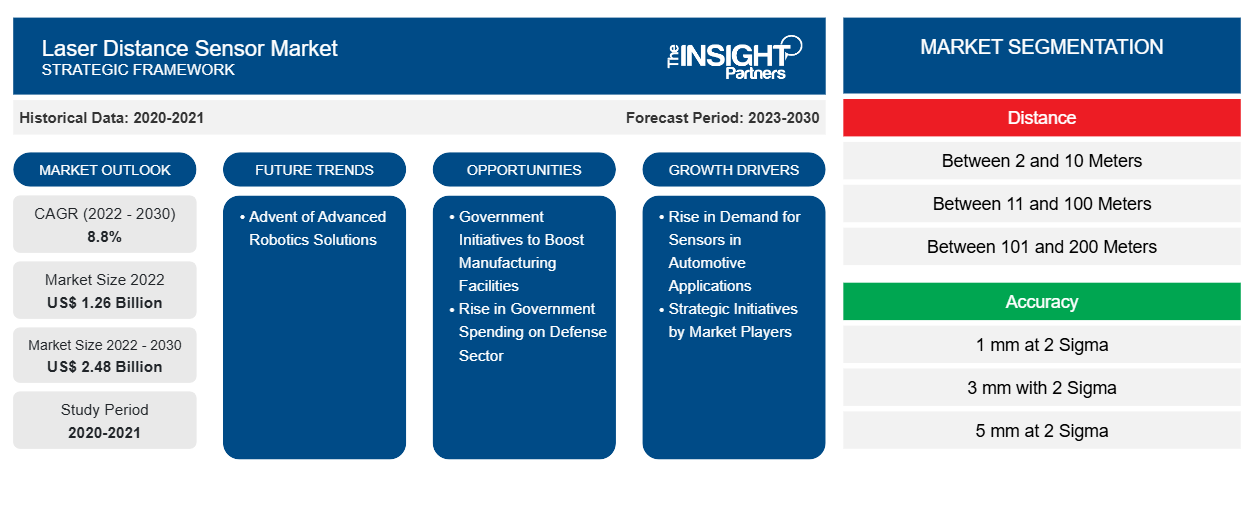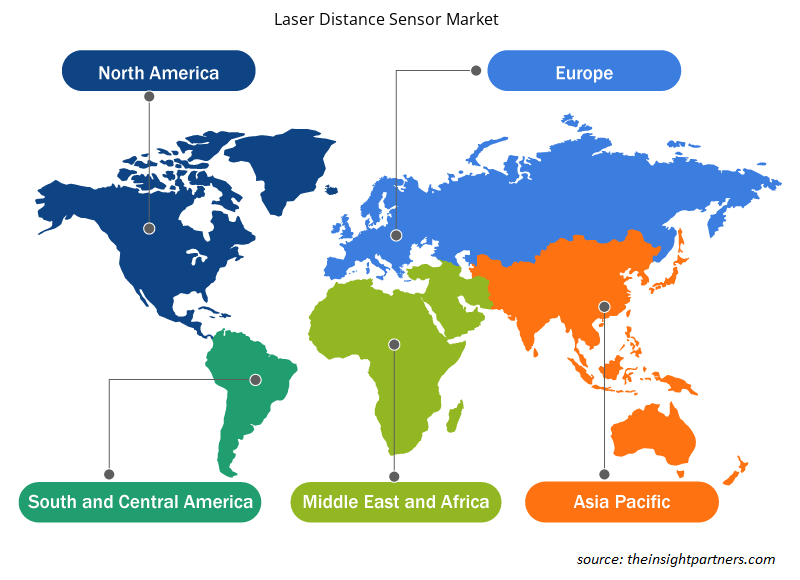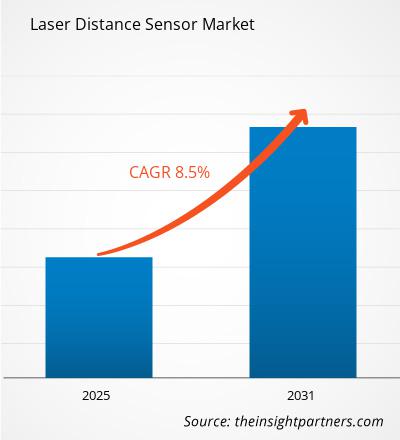레이저 거리 센서 시장 규모는 2024년 21억 4천만 달러로 평가되었으며, 2031년에는 37억 3천만 달러에 이를 것으로 예상됩니다 . 2025년부터 2031년까지 연평균 성장률(CAGR)은 8.5%에 이를 것으로 예상됩니다. 첨단 로봇 솔루션의 등장은 앞으로도 주요 시장 트렌드로 남을 것으로 예상됩니다.
레이저 거리 센서 시장 분석
제조 시설 자동화에 대한 정부의 관심이 높아짐에 따라 레이저 거리 센서에 대한 수요가 증가하고 있습니다. 첨단 센싱 기술은 제조 시설의 운영 효율성을 향상하는 데 도움이 됩니다. 따라서 제조업 육성을 위한 정부 투자 증가는 레이저 거리 센서 시장 성장을 촉진합니다. 또한, 자동차 산업은 레이저 거리 센서의 주요 응용 분야 중 하나입니다. 자동차에 첨단 기술이 접목되면서 레이저 거리 센서 시장이 성장하고 있습니다.
레이저 거리 센서 시장 개요
레이저 거리 센서는 레이저 빔을 사용하여 물체 사이의 거리를 계산하는 부품입니다. 이 센서는 거리를 측정하고 장거리에서도 정확한 측정을 가능하게 합니다. 센서가 레이저 빔을 발사하고 반사된 빛을 수신하는 비행 시간( ToF ) 원리를 기반으로 작동합니다. 레이저 빔을 송신하고 수신하는 데 걸리는 시간을 통해 레이저 거리 센서가 거리를 측정합니다.
귀하의 요구 사항에 맞게 이 보고서를 사용자 정의하세요
이 보고서의 일부 또는 국가 수준 분석, Excel 데이터 팩을 포함하여 모든 보고서에 대한 사용자 정의를 무료로 받을 수 있으며, 신생 기업 및 대학을 위한 훌륭한 혜택과 할인도 이용할 수 있습니다.
레이저 거리 센서 시장: 전략적 통찰력

- 이 보고서에서 주요 시장 동향을 알아보세요.이 무료 샘플에는 시장 동향부터 추정치 및 예측까지 다양한 데이터 분석이 포함됩니다.
레이저 거리 센서 시장 성장 요인 및 기회
자동차 애플리케이션에서 센서 수요 증가
자동차 산업은 기술 발전의 급속한 진전과 함께 빠르게 성장하고 있습니다. 자동차는 효과적인 감지 기술을 통해 자율주행 시스템이 운전자를 지원하고 더 나은 안전성, 편의성, 그리고 편의성을 제공할 수 있도록 지원합니다. 레이저 거리 센서는 자율주행차에서 위치 측정, 장애물 감지, 물체 감지 및 배치 등 다양한 용도로 사용됩니다. 이 기술은 물체 감지를 지원하고 3차원 공간 내 물체의 위치와 움직임에 대한 정보를 제공합니다. 또한 물체의 크기, 모양, 방향을 감지하여 식별하는 데에도 도움을 줍니다.
자동차 산업 전반에 걸친 지속적인 변화는 첨단 운전자 보조 시스템(ADAS)과 광 검출 및 거리 측정( LiDAR )에 대한 수요를 촉진했습니다. ADAS 및 LiDAR 애플리케이션에서 높은 수준의 정확도와 이기종 신호 중복성에 대한 요구가 증가함에 따라 레이저 거리 센서에 대한 수요가 증가하고 있습니다. 여러 자동차 제조업체들이 ADAS 및 LiDAR 기술에 집중하고 있습니다. 따라서 자동차 제조업체들의 ADAS 기술 도입은 차량의 고도화된 자동화에 필요한 신뢰성을 향상시키기 위한 레이저 거리 센서에 대한 수요를 창출하고, 이는 레이저 거리 센서 시장 성장을 더욱 촉진합니다.
제조 시설 강화를 위한 정부 이니셔티브
인더스트리 4.0은 기업의 제품 제조, 가공 및 유통 방식을 혁신하고 있으며, 인적 오류 위험을 최소화하고 안전한 환경을 제공하여 제품 품질을 개선하는 데 중점을 두고 있습니다. 인더스트리 4.0 도입이 증가함에 따라 여러 국가 정부가 제조업을 더욱 발전시키기 위해 투자하고 있습니다. 예를 들어, 2025년 3월, 존슨앤드존슨은 향후 4년간 미국에 제조, 연구 개발 및 기술 분야에 550억 달러를 신규 투자한다고 발표했습니다. 또한, '메이크 인 인디아(Make in India)' 및 '메이크 인 차이나 2025(Made in China 2025)'와 같은 이니셔티브는 시장 참여자들이 제조 역량을 확장하고 첨단 기술을 도입하여 생산량을 촉진하고 최종 제품의 효율성을 향상시키도록 지원하고 있습니다. 산업화의 진전은 자동차, 식음료, 화학 등 다양한 산업 분야에서 새로운 제조 시설 건설 에 기여하여 특정 작업을 수행하는 자동화 솔루션의 필요성을 더욱 높이고 있습니다. 레이저 거리 센서는 향상되고 오류 없는 제조 공정을 위해 실시간 정밀 측정을 제공하는 데 중요한 역할을 할 수 있습니다. 새로 건설되는 자동화 제조 시설은 품질 관리 개선, 생산성 향상, 그리고 전반적인 비용 효율성 향상에 필요한 부품 수요를 창출합니다. 따라서 정부가 제조 시설 확충 및 자동화 통합에 집중하는 것은 레이저 거리 센서 시장 성장에 수익성 있는 기회를 창출할 것으로 예상됩니다.
레이저 거리 센서 시장 보고서 세분화 분석
레이저 거리 센서 시장 분석에 기여한 주요 세그먼트는 파장, 전력 범위 및 최종 사용자입니다.
- 레이저 거리 센서 시장은 파장 기준으로 200~650nm, 651~1100nm, 1101~3000nm, 그리고 3001nm 이상으로 구분됩니다. 3001nm 이상 세그먼트는 2024년에 가장 큰 시장 점유율을 기록했습니다.
- 레이저 거리 센서 시장은 출력 범위 기준으로 1mW 미만, 1~100mW, 101mW~500mW, 500mW 이상으로 구분됩니다. 101mW~500mW 부문은 2024년에 가장 큰 시장 점유율을 기록했습니다.
- 산업별로 시장은 제조, 건설, 자동차 및 로봇, 항공우주 및 방위, 지공간 산업, 환경 모니터링 등으로 세분화됩니다. 자동차 및 로봇 분야는 2024년에 레이저 거리 센서 시장 점유율 1위를 차지했습니다.
지역별 레이저 거리 센서 시장 점유율 분석
- 레이저 거리 센서 시장은 북미, 유럽, 아시아 태평양(APAC), 중동 및 아프리카(MEA), 중남미의 5개 주요 지역으로 구분됩니다. 2024년에는 아시아 태평양 지역이 시장을 주도했으며, 북미와 유럽이 그 뒤를 이었습니다.
- 아시아 태평양 지역에서는 인도, 중국, 일본 등 여러 국가에서 산업 자동화가 확대되고 있으며, 이는 시장 성장을 견인하는 주요 요인입니다. 제조, 물류, 자동차 등 다양한 분야에서 산업 자동화가 널리 도입되고 있는 것은 레이저 거리 센서 시장의 주요 성장 동력입니다. 레이저 거리 센서는 정확하고 신뢰할 수 있는 거리 측정을 제공하여 정밀한 위치 결정, 물체 감지 및 충돌 방지를 가능하게 함으로써 자동화 분야에서 중요한 역할을 합니다. 2024년 7월, 중국 자동차 제조업체인 BYD는 태국에 첫 전기차 공장을 설립하며 동남아시아 시장으로의 본격적인 확장을 알렸습니다. BYD는 빠르게 성장하는 이 시장에서 선두 주자로 자리매김했습니다. BYD 공장은 정부 보조금과 세제 혜택을 바탕으로 태국에 공장을 설립 중인 중국 전기차 제조업체들의 14억 4천만 달러 이상의 투자의 일환입니다. 이번 대규모 수주는 첨단 자동화 기술을 활용하고 제조 공정의 운영 효율성을 향상시키려는 BYD의 노력을 보여줍니다.
레이저 거리 센서 시장 지역별 통찰력
Insight Partners의 분석가들은 예측 기간 동안 레이저 거리 센서 시장에 영향을 미치는 지역별 동향과 요인을 면밀히 분석했습니다. 이 섹션에서는 북미, 유럽, 아시아 태평양, 중동 및 아프리카, 그리고 중남미 지역의 레이저 거리 센서 시장 부문 및 지역별 현황도 살펴봅니다.

- 레이저 거리 센서 시장에 대한 지역별 데이터 얻기
레이저 거리 센서 시장 보고서 범위
| 보고서 속성 | 세부 |
|---|---|
| 2024년 시장 규모 | 21억 4천만 달러 |
| 2031년까지 시장 규모 | 37억 3천만 달러 |
| 글로벌 CAGR(2025~2031년) | 8.5% |
| 역사적 데이터 | 2021-2023 |
| 예측 기간 | 2025-2031 |
| 다루는 세그먼트 | 파장별로
|
| 포함된 지역 및 국가 | 북아메리카
|
| 시장 선도 기업 및 주요 회사 프로필 |
|
레이저 거리 센서 시장 참여자 밀도: 비즈니스 역학에 미치는 영향 이해
레이저 거리 센서 시장은 소비자 선호도 변화, 기술 발전, 그리고 제품 이점에 대한 인식 제고 등의 요인으로 인한 최종 사용자 수요 증가에 힘입어 빠르게 성장하고 있습니다. 수요가 증가함에 따라 기업들은 제품 라인업을 확장하고, 소비자 니즈를 충족하기 위한 혁신을 추진하며, 새로운 트렌드를 적극 활용하고 있으며, 이는 시장 성장을 더욱 가속화하고 있습니다.
시장 참여자 밀도는 특정 시장이나 산업 내에서 활동하는 기업들의 분포를 나타냅니다. 이는 특정 시장 공간에 얼마나 많은 경쟁자(시장 참여자)가 존재하는지를 규모나 전체 시장 가치 대비로 나타냅니다.
레이저 거리 센서 시장에서 활동하는 주요 회사는 다음과 같습니다.
- 아픈 AG
- ifm Electronic GmbH
- 육각형 AB
- iC-Haus GmbH
- 하마마츠 포토닉스 주식회사
- 로이체 일렉트로닉 GmbH & Co KG
면책 조항 : 위에 나열된 회사는 특정 순서에 따라 순위가 매겨지지 않았습니다.

- 레이저 거리 센서 시장의 주요 기업 개요를 확인하세요
레이저 거리 센서 시장 뉴스 및 최근 동향
레이저 거리 센서 시장은 1차 및 2차 조사 후 주요 기업 간행물, 협회 자료, 데이터베이스 등 정성적 및 정량적 데이터를 수집하여 평가합니다. 레이저 거리 센서 시장의 몇 가지 동향은 다음과 같습니다.
- 독일의 저명한 센서 및 자동화 기업인 ifm Electronic GmbH가 인도네시아의 "Making Indonesia 4.0" 이니셔티브의 성공에 기여하기 위해 인도네시아에 진출을 확대했습니다. ifm Electronic GmbH는 2022년 10월 10일 인도네시아 자회사인 PT ifm electronic Indonesia를 설립했습니다. 이후 2023년 8월 3일, 자카르타 센트럴 세나얀 II에 사무실을 개소하고 성대한 개소식을 거행했습니다. 이번 개소식은 인도네시아 시장 진출 및 산업 발전 지원에 대한 ifm Electronic GmbH의 의지를 보여줍니다. (출처: ifm Electronic GmbH, 보도자료, 2023년 8월)
- 센서, 인코더, 계측기 및 자동 이미징 부품 분야의 선도적인 제조업체인 바우머 그룹(Baumer Group)이 멕시코에 새로운 자회사를 설립했습니다. 멕시코 산티아고데케레타로에 위치한 새로운 지사를 통해 바우머는 현재 전 세계 19개국에 진출하여 39개의 개발 센터, 생산 시설 및 영업 부서를 운영하고 있습니다.
(출처: 바우머 그룹, 보도자료, 2025년 1월)
레이저 거리 센서 시장 보고서 범위 및 제공 내용
"레이저 거리 센서 시장 규모 및 예측(2021~2031)"은 아래 언급된 영역을 포괄하는 시장에 대한 자세한 분석을 제공합니다.
- 범위에 포함된 모든 주요 시장 부문에 대한 글로벌, 지역 및 국가 수준의 레이저 거리 센서 시장 규모 및 예측
- 레이저 거리 센서 시장 동향 및 드라이버, 제약 및 주요 기회와 같은 시장 역학
- 자세한 PEST 및 SWOT 분석
- 주요 시장 동향, 글로벌 및 지역 프레임워크, 주요 업체, 규정 및 최근 시장 개발 사항을 다루는 레이저 거리 센서 시장 분석
- 시장 집중도, 히트맵 분석, 주요 업체 및 레이저 거리 센서 시장의 최근 개발 사항을 다루는 산업 환경 및 경쟁 분석
- 자세한 회사 프로필
- 과거 분석(2년), 기준 연도, CAGR을 포함한 예측(7년)
- PEST 및 SWOT 분석
- 시장 규모 가치/거래량 - 글로벌, 지역, 국가
- 산업 및 경쟁 환경
- Excel 데이터세트
최근 보고서
관련 보고서
사용 후기
구매 이유
- 정보에 기반한 의사 결정
- 시장 역학 이해
- 경쟁 분석
- 고객 인사이트
- 시장 예측
- 위험 완화
- 전략 기획
- 투자 타당성 분석
- 신흥 시장 파악
- 마케팅 전략 강화
- 운영 효율성 향상
- 규제 동향에 발맞춰 대응




















 무료 샘플 받기 - 레이저 거리 센서 시장
무료 샘플 받기 - 레이저 거리 센서 시장